The network has its reasons that reason ignores. Laurent was recently able to put me in touch with two supervisors from the PSF network to substitute for him at their annual conference. It was with great curiosity that I undertook this approach. The curiosity seemed to be shared on the other side. The idea was to present in two sessions how one can supervise a group of agile coaches with my dual position: organizational coach, and general manager at beNext.
It was a supervisors’ conference. The PSF conference. Unsurprisingly, I met some fascinating people, involved, with their feet firmly planted in reality, and some appalling people, at the opposite end of what they advocate.
Supervising agile coaches?
At beNext we hold every two weeks a day that includes intervision. This day allows us to deal with many subjects, tensions, celebrations, to synchronize everyone on current events. All these conversations can lead to exchange and intervision sessions. I spoke about the importance of being legitimate to be heard in this circle. I spoke about the importance of confrontation (in which I believe strongly, healthy confrontation). I spoke about the quality of agile coaches being crossover, multidisciplinary. It’s their strength, but also their weakness, because there are many sorcerer’s apprentices, as in all coaching, not so well supervised (professional coaching federations are far from having earned my respect). I spoke about the importance of being vulnerable, of showing one’s shortcomings and failures, of showing these attempts, successful as well as unsuccessful.
At beNext we also offer triads, individual one-on-one meetings with a third person who comes at the invitation of the subject person, to integrate a different perspective, more “meta” conversations.
At beNext we also offer coach corners: it’s an open space for anyone who wants coaching as they wish (professional, personal, etc.).
Thanks to Élisabeth Georges and Éveline Forlot for accompanying me in this reflection. Élisabeth gave me a key about the crossover aspect by telling me that we respond at all logical levels. She also enlightened me when I spoke to her about supporting organizations, about “focusing on the entire supervised system, in a global vision, rather than on a specific problem” and the difficulty for some to know who the client is. To summarize, probably crudely, the client is the payer. Thus in organizational coaching, and more broadly in agile coaching, the client is the organization. What she calls systemic coaching. For humanistic coaching (these are her words), in individual coaching, the client is the individual.
Apart from this conversation around the supervision of agile coaches, I retain two subjects that I had already been able to discuss here and there.
More frequent decisions
In this VUCA world (I can’t get used to this acronym, volatile, uncertain, complex and ambiguous) decisions are more numerous and more frequent. We advance step by step, we must decide more often. And observe, inspect, learn. Deciding more often also means allowing oneself to decide more easily (more autonomy).
Saying it’s been 15 years or asking the right questions
People often tell me recently: “it’s been 15 years…” or “it’s been 25 years…”. I had fun saying during a seminar: “you all know this quote from the president of Kodak: it’s been 25 years… (pause) unless it’s from the one at Thomas Cook?”. Everyone understood.
We live in a complicated world where imposing habits or knowledge that one thinks is acquired (“it’s been 25 years”) can prove to be a trap, because it is no longer acquired, precisely. It’s a changing world, we just told ourselves, it then seems ironic to call upon one’s habits. However, only time seems to judge a good emergence (the Lindy effect from “skin in the game” by Nassim Taleb). It’s when time has passed that emergence has validated its quality. Between validating with time (and probably expanding) something emergent, and breaking with one’s habits built (and perhaps expanded too) with time, the reading is not simple for everyone. Yet no identical repetition in emergence.
Since it’s a question of time, what do we know at time t? What could we know?
1° who are we? What do we want? We can know this.
2° are our actions bearing fruit and what fruit? We can know this.
The two extremes of Dilts’ pyramid, Élisabeth Georges points out to me. All the work is to traverse it. If we traverse it well without dissonance, we obtain an adequate environment.
